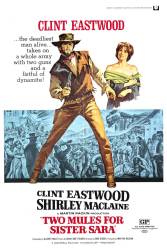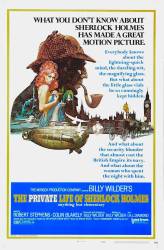
Other mistake: When the Japanese planes take off for Pearl Harbor, some of the 3 man torpedo planes only have a pilot.

Continuity mistake: When Edgar takes Duchess and the kittens to be abandoned in the countryside, he is on a motorcycle and sidecar combination. During the trip, the sidecar changes from one side of the bike to the other and back again. Also, when the sidecar separates from the motorcycle while the dogs are chasing Edgar, the wheel on the sidecar switches sides regularly as well.

Factual error: So the Civil War ends, and the colonel heads for Texas. It must have taken close to a decade to arrive there, for when he rides into Blackthorne, Texas, he's packing a Model 1873 Colt, and a Model 1873 Winchester.

Revealing mistake: During the Little Bighorn massacre one of Custer's lieutenants turns to address Custer and is struck in the back with an arrow, and the thick pad or board is visible under the actor's shirt.

Revealing mistake: That isn't Joan Sims in the shower as seen from above. The stand-in doesn't remotely resemble her.

Factual error: When Clint Eastwood catches an Indian arrow in his left shoulder, he instructs Shirley MacLaine to prime the arrow shaft with gunpowder, which he then ignites as she forces the shaft all the way through his shoulder. Presumably, the burning gunpowder would cauterize the wound all the way through his body, or that's what the filmmakers asked the audience to believe. In reality, gunpowder is historically well-known for causing gangrene in open wounds. With a shoulder full of gunpowder cinders, Clint Eastwood should have died of gangrene and sepsis by the end of the movie.

Other mistake: Like most Sherlock Holmes films 'The Private Life Of Sherlock Holmes' is set in Victorian England: Queen Victoria even makes an appearance. Holmes and Watson go to Loch Ness in Scotland, where they see the Loch Ness monster. (Spoiler alert) it turns out that the Loch Ness Monster is not a living creature, but an experimental submarine. Like most people who would have seen the film on its release in 1970, they are familiar with the Loch Ness monster (even if they do not necessarily believe in it). But the first documented sightings of the Loch Ness Monster were only made in 1933. Nobody ever thought there might have been a monster in Loch Ness before 1933.
Suggested correction: Sightings and lore of the Loch Ness Monster date back over 1,500 years. In fact, the indigenous people of the region carved images of the monster into stone as far back as 500 AD. The 1933 hoax was certainly not the first time the monster was sighted; however, the hoax was inspired by the centuries-old Loch Ness legend, of which Holmes, Watson and everyone else would be well aware in the Victorian era.
The only carved images from that period are Pictish symbol stones, none of which are particularly associated with Loch Ness.
On the contrary, the Pictish "Drumbuie Stone" (recovered at Drumbuie Farm on Loch Ness in the mid-19th Century) depicts a large serpentine creature, very much matching traditional descriptions of the Loch Ness monster. Https://canmore.org.uk/site/12626/drumbuie.
Suggested correction: This is somewhat incorrect. The 1933 photograph that was published in newspapers may have brought the idea of a Loch Ness Monster to a wider audience, reports of a creature in Loch Ness (or Loch River) were around long before then. And just because the term "Loch Ness Monster" may have first been printed in 1933 doesn't mean the term didn't exist before then. In a fictional story surrounding fictional events, there's no mistake in bringing up a creature already rumored to have existed.
Well observed sir! I thought somebody might well say that. Maybe I should have gone into more detail. May I make it clear that I have absolutely no problem with a sighting of the Loch Ness Monster in a Sherlock Holmes film, since Sherlock Holmes was a fictional character, and 'The Private Life Of Sherlock Holmes' was an imaginary story. (Plus the film contained some intentionally comic elements, it was a bit 'tongue in cheek', so lets not take it too seriously!) But lets look at the history of sightings of the monster. The first sighting to attract widespread attention was on 22 July 1933, when the Spicers saw a creature near (but not in) the Loch. On 12 November Hugh Gray took the photograph you allude to. In 1934 Rupert Gould published the first book about it. You say that earlier sightings may not have been widely reported. You are quite correct! One D. Mackenzie said he saw a monster in the Loch in 1872, but did not tell anybody at the time. A sixth century life of St. Columba records an encounter with a 'water beast' in the River Ness. My point was that, in the film, Holmes, Watson, and most other people, are familiar with the story of the Loch Ness Monster. (Spoiler alert again) : The 'monster' is an experimental submarine, which Sherlock's brother, Mycroft, is helping the war office to develop. To stop people realising they were experimenting with new military technology, they would develop the submarine in Loch Ness, so anybody seeing it would think it was the Monster (to add to the deception they give it an artificial neck and head). My point is that, while most people who saw the film in 1970, and most people using this website, would be quite familiar with the story of the Loch Ness Monster. So, whether or not they believe in its existence, they would get the joke (after all, the film was not meant to be taken completely seriously). In the Victorian era the Loch Ness Monster would, at best, have been a local rumour, not something that was known worldwide so it is doubtful that even people as undoubtedly intelligent as Holmes and Watson would have known about it. If they saw a monster in Loch Ness they would not say 'Oh, that's the Loch Ness Monster'. They would ask 'Whatever is that great big thing going through the water?'.